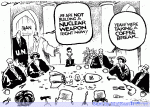Host:
Demonstration by National Coalition of Iranians and supporters of the National Council of Resistance of Iran. We will discuss the event with demonstration spokesman, Mr. Nasser Rashidi via telephone.
Mr. Nasser Rashidi:
The rally yesterday was a large demonstration which began at the U.S. Congress, through Pennsylvania Avenue, that ended at the White House. Participants included representatives from organizations from different U.S. states, youth organizations, intellectuals, and active women’s organizations in the United States who in the past few weeks were instrumental in organizing similar demonstrations and sit-ins at their respective home states. They decided to converge in Washington, DC yesterday to unite around a central axis. Their unanimity is based on the plan adopted by the National Solidarity Front and the National Council of Resistance adopted in 1981.
The plan emphasizes solidarity of republican forces who reject the velayat-e-faghih regime and its differing fractions and who struggle to establish a political, democratic, and independent government based on separation of church and state. The National Solidarity Front has adopted these 3 requirements as the basis of cooperation. Yesterday we happily saw vivid example this solidarity.
I would especially like to reiterate to my fellow citizens inside Iran that their efforts, struggles, and sacrifices are thankfully bearing fruit. For example, we had participation from youth who have never been to Iran but took an active role as speakers, planners, and organizers of yesterday’s demonstration. Especially active were female students who were inspired by the popular uprising in Iran. The bravery they saw in Iran has unleashed their enormous potential which we will surely witness in their future plans and expressions of solidarity with the Iranian people. As the New York Times reported, women and girls were the leaders of the uprising within Iran. Here too, we gladly saw the youth play a similarly magnificent role in the rally.
Key demands of the demonstrators were: elections under supervision of the United Nations, economic and diplomatic sanctions until oppression stops, dispatch of an international delegation to Iran to investigate the atrocities committed there, and forwarding the case of regime officials responsible for the massacre to the U.N. Security Council.









